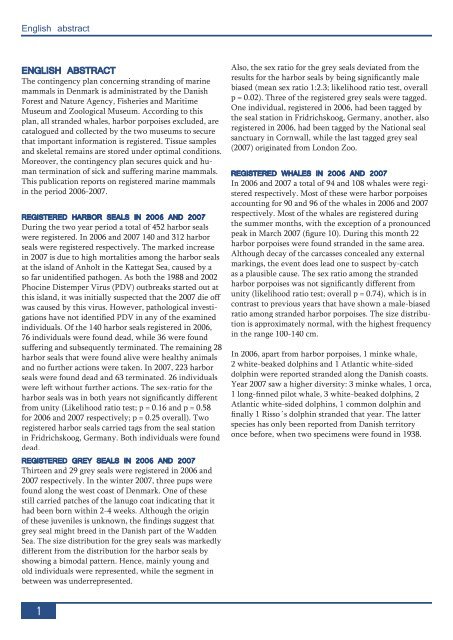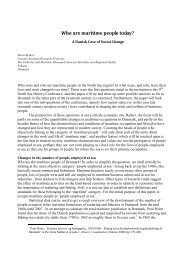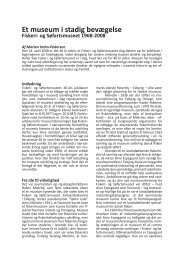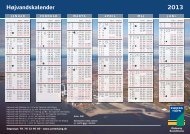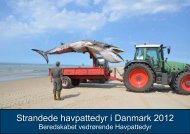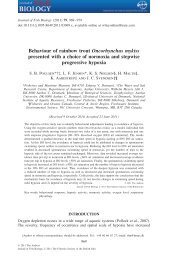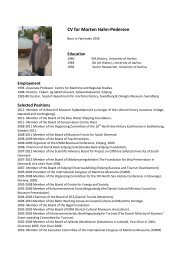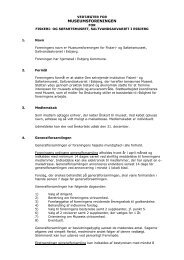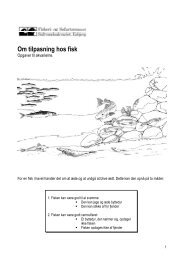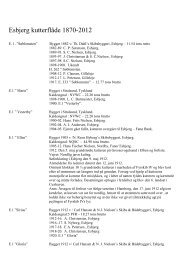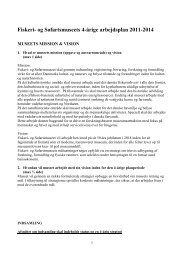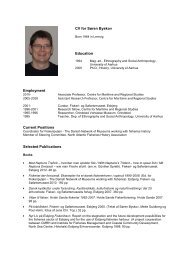2006-07 - Fiskeri- og Søfartsmuseet
2006-07 - Fiskeri- og Søfartsmuseet
2006-07 - Fiskeri- og Søfartsmuseet
You also want an ePaper? Increase the reach of your titles
YUMPU automatically turns print PDFs into web optimized ePapers that Google loves.
English abstract<br />
ENGLISH ABSTRACT<br />
The contingency plan concerning stranding of marine<br />
mammals in Denmark is administrated by the Danish<br />
Forest and Nature Agency, Fisheries and Maritime<br />
Museum and Zool<strong>og</strong>ical Museum. According to this<br />
plan, all stranded whales, harbor porpoises excluded, are<br />
catal<strong>og</strong>ued and collected by the two museums to secure<br />
that important information is registered. Tissue samples<br />
and skeletal remains are stored under optimal conditions.<br />
Moreover, the contingency plan secures quick and human<br />
termination of sick and suffering marine mammals.<br />
This publication reports on registered marine mammals<br />
in the period <strong>2006</strong>-20<strong>07</strong>.<br />
REGISTERED HARBOR SEALS IN <strong>2006</strong> AND 20<strong>07</strong><br />
During the two year period a total of 452 harbor seals<br />
were registered. In <strong>2006</strong> and 20<strong>07</strong> 140 and 312 harbor<br />
seals were registered respectively. The marked increase<br />
in 20<strong>07</strong> is due to high mortalities among the harbor seals<br />
at the island of Anholt in the Kattegat Sea, caused by a<br />
so far unidentified path<strong>og</strong>en. As both the 1988 and 2002<br />
Phocine Distemper Virus (PDV) outbreaks started out at<br />
this island, it was initially suspected that the 20<strong>07</strong> die off<br />
was caused by this virus. However, pathol<strong>og</strong>ical investigations<br />
have not identified PDV in any of the examined<br />
individuals. Of the 140 harbor seals registered in <strong>2006</strong>,<br />
76 individuals were found dead, while 36 were found<br />
suffering and subsequently terminated. The remaining 28<br />
harbor seals that were found alive were healthy animals<br />
and no further actions were taken. In 20<strong>07</strong>, 223 harbor<br />
seals were found dead and 63 terminated. 26 individuals<br />
were left without further actions. The sex-ratio for the<br />
harbor seals was in both years not significantly different<br />
from unity (Likelihood ratio test; p = 0.16 and p = 0.58<br />
for <strong>2006</strong> and 20<strong>07</strong> respectively; p = 0.25 overall). Two<br />
registered harbor seals carried tags from the seal station<br />
in Fridrichsko<strong>og</strong>, Germany. Both individuals were found<br />
dead.<br />
REGISTERED GREY SEALS IN <strong>2006</strong> AND 20<strong>07</strong><br />
Thirteen and 29 grey seals were registered in <strong>2006</strong> and<br />
20<strong>07</strong> respectively. In the winter 20<strong>07</strong>, three pups were<br />
found along the west coast of Denmark. One of these<br />
still carried patches of the lanugo coat indicating that it<br />
had been born within 2-4 weeks. Although the origin<br />
of these juveniles is unknown, the findings suggest that<br />
grey seal might breed in the Danish part of the Wadden<br />
Sea. The size distribution for the grey seals was markedly<br />
different from the distribution for the harbor seals by<br />
showing a bimodal pattern. Hence, mainly young and<br />
old individuals were represented, while the segment in<br />
between was underrepresented.<br />
Also, the sex ratio for the grey seals deviated from the<br />
results for the harbor seals by being significantly male<br />
biased (mean sex ratio 1:2.3; likelihood ratio test, overall<br />
p = 0.02). Three of the registered grey seals were tagged.<br />
One individual, registered in <strong>2006</strong>, had been tagged by<br />
the seal station in Fridrichsko<strong>og</strong>, Germany, another, also<br />
registered in <strong>2006</strong>, had been tagged by the National seal<br />
sanctuary in Cornwall, while the last tagged grey seal<br />
(20<strong>07</strong>) originated from London Zoo.<br />
REGISTERED WHALES IN <strong>2006</strong> AND 20<strong>07</strong><br />
In <strong>2006</strong> and 20<strong>07</strong> a total of 94 and 108 whales were registered<br />
respectively. Most of these were harbor porpoises<br />
accounting for 90 and 96 of the whales in <strong>2006</strong> and 20<strong>07</strong><br />
respectively. Most of the whales are registered during<br />
the summer months, with the exception of a pronounced<br />
peak in March 20<strong>07</strong> (figure 10). During this month 22<br />
harbor porpoises were found stranded in the same area.<br />
Although decay of the carcasses concealed any external<br />
markings, the event does lead one to suspect by-catch<br />
as a plausible cause. The sex ratio among the stranded<br />
harbor porpoises was not significantly different from<br />
unity (likelihood ratio test; overall p = 0.74), which is in<br />
contrast to previous years that have shown a male-biased<br />
ratio among stranded harbor porpoises. The size distribution<br />
is approximately normal, with the highest frequency<br />
in the range 100-140 cm.<br />
In <strong>2006</strong>, apart from harbor porpoises, 1 minke whale,<br />
2 white-beaked dolphins and 1 Atlantic white-sided<br />
dolphin were reported stranded along the Danish coasts.<br />
Year 20<strong>07</strong> saw a higher diversity: 3 minke whales, 1 orca,<br />
1 long-finned pilot whale, 3 white-beaked dolphins, 2<br />
Atlantic white-sided dolphins, 1 common dolphin and<br />
finally 1 Risso´s dolphin stranded that year. The latter<br />
species has only been reported from Danish territory<br />
once before, when two specimens were found in 1938.<br />
1


